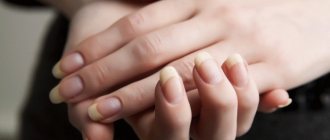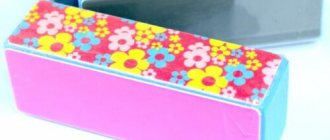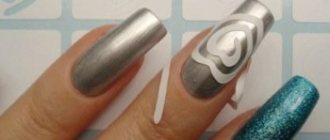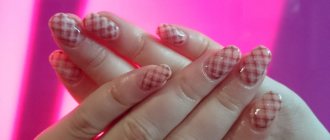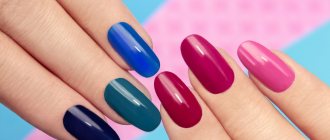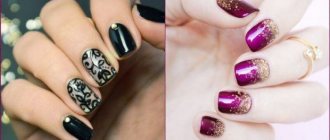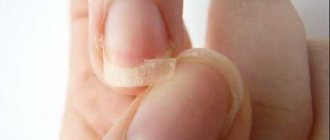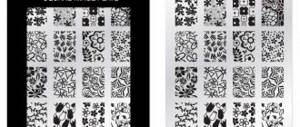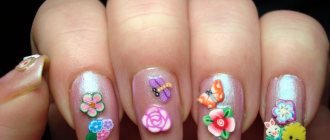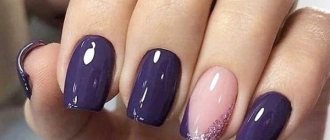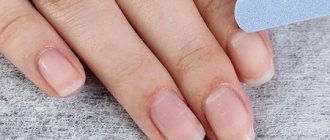The most important tool for performing a manicure is nail files. They are used to perform manicure on nails without coating and with it. A high-quality manicure depends on the nail file.
Abrasiveness is a term used to describe the hardness of a tool. It is indicated in grits. When a high number is written, the tool is soft, and if the number is low, then the file is hard.
Classification of manicure tools:
- Made from glass
- Made of ceramics
- Using diamond coating
- Metal nail files
- Paper files
- Made of plastic
- Files produced using a laser
Glass files
These files last a long time, are easy to use and do not injure the nail plate during manicure. There are no pores or cracks in the structure of the files, so dirt will not linger in them and microbes will not multiply. Sterilization of such an instrument is permissible in any of the possible ways.
The only negative is that sometimes such files can break if the master drops it or simply does not notice and places something heavy on top. To prevent this from happening, buy a protective cover for the nail file. And then it will serve the master for as long as possible.
Ceramic files
These files also have a number of advantages. They have a low price and are gentle on nails. True, such products are suitable for performing manicures on natural nails. They have a structure that allows you to maximally tidy up the exfoliating nail plate. Ceramic files, like glass files, are fragile - so they need to be used with the utmost caution. If handled correctly, they will serve the master for a very long time.
Files made using diamond coating
Diamond files are best for nails that break frequently. They will help you create a high-quality manicure on both natural and extended nails. To make them, the method of spraying diamond chips onto a file is used. The latter polishes nails well and seals the tips. This file is universal and suitable for both use in the salon and at home.
Metal files
Perhaps the most popular tools. They have been used for a very long time, and almost every woman has such a file in her arsenal. But such a tool has a significant disadvantage. It can injure the nail plate. It is used to file down extended nails. But this must be done delicately so as not to damage the top layer of the nail.
Paper files
They are made from hard cardboard or a thick layer of paper. A special crumb is applied on top. It can be made of granite, quartz or Teflon. This product is usually for one-time use. It is not possible to disinfect such a file. But if a girl buys it for individual use, then she can use it on an ongoing basis. This product is short-lived and wears out quickly.
This tool for treating the nail plate is the most common and is in every girl’s cosmetic bag. They are inexpensive, durable and strong. Suitable for all types of nails. Thanks to the large assortment, every girl will find a plastic file to her liking.
These tools often have a rougher surface for deep filing and a softer surface that is suitable for thin and easily broken nails.
Laser files
This tool has not yet entered mass use among girls and manicure professionals. This file has the appearance of a honeycomb on a metal surface. In its manufacture, spraying is used. It is called laser because it is created using a laser manufacturing method. This tool not only corrects the shape of the nails, polishes and files uneven areas, but also removes overgrown cuticles.
These products are durable, easy to use and suitable for problematic nails without causing them to split or spoil the structure. The file can be washed using detergent and disinfected by soaking in a solution.
Nail files are also divided by shape:
- In the form of a long rectangle. These files are very popular and are suitable for both the salon and home. They have two sides. One side is harder, the other is softer.
- Oval shape. The length and shape of the nail is adjusted.
- Diamond shapes. This file is used by professional nail technicians.
- Boomerang file. Such tools are used to give nails a specific shape, if you suddenly need to change a square shape to a rounded one or vice versa.
- Buff file. Used in the process of polishing the nail plate before coating or extensions.
What files are used for manicure on uncoated nails?
For such nails, files with a high grit number are used. Products with a value of 900-1300 are used for polishing the nail; due to their softness, they do not injure the plate.
With a numeric rating of 400-850 grit, the tools are suitable for normal nails that are sometimes prone to splitting. These files are used before applying the gel, but before sanding. They eliminate all unevenness of the nail and its tips.
There are also files of 240-350 grit, they are less soft than others and are suitable for manicure on healthy nails, giving it shape and forming it to a suitable length.
Attention - abrasiveness
Masters who specialize in creating manicures are often interested in what to look for in order to make the right choice of this device.
When choosing nail files, shape, size and color are not as important as the degree of abrasiveness, that is, the hardness of its working surface. There is a unit of abrasiveness - grit. The lower the grit number, the harder the surface of the file. And depending on the rigidity of the file, the purpose of this tool is determined.
So, for natural nails, it is better to choose a file with a higher grit reading - there is less chance of injury to the nail plate, but it is more difficult to shape it. To shape natural nails, it is better to choose a file with a hardness of 240 grit. To polish and add shine to the nail plate, you need a tool with an abrasiveness of 900–1200 grit.
How the grit number corresponds to the purpose of the file can be found in the following table.
- 60–100 grit. The hardest files. They are suitable for pedicures and easily cope with corns
- 100–240 grit. Slightly softer, but still quite abrasive files. They can only be used on artificial nails. Even the strongest natural nails will peel if they are shaped with a file this abrasive.
- 240 grit The most versatile option. Files of this hardness are suitable for any natural and artificial nails
- 250–400 grit. Ideal for polishing, completing the process of correcting the shape of nails
- 400–900 grit. Soft, help prepare nails for polishing
- 900–1200 grit. As a rule, these are soft buffs that can be used to polish your nails to a mirror shine without causing harm to the nail plate.
A little theory
The nail plate consists of small scales that fit tightly together
What files are used for nail extensions?
In this case, fairly hard files are used - 55-85 grit. They are very hard and are used to correct the length and polish the extended layer of the nail plate.
Files from 95 to 145 grit are used to remove the top gel layer, as well as to change the shape. But products with a hardness of 15-250 grit are also suitable for ordinary nails, but are still more often used for filing artificial coating.
Classification of files by shape
Nail files are made in various shapes. This allows you to choose the option that is suitable and convenient for you. Let's look at several popular forms of abrasive cloth.
Rectangular
Considered a classic form. It is convenient to use if you need to treat your nails on both your toes and hands or even out the nail surface. Easily adjusts the length and shapes your nails during manicure and pedicure.
Straight files can be made of any material; this shape is most often found in metal, paper, glass and ceramic files.
Oval
A file of this shape is suitable for correcting the nail plate and giving it the desired shape. for rounded nail shapes and filing artificial ones at the cuticle.
Boomerang shaped
These files are also called “banana” or “crescent” and they are best suited for home manicure. The very convenient curved shape of this file perfectly files extended nails without damaging the cuticle. On natural nails it is used to create a rounded shape.
Curly
For manicurists, professional nail files are produced in the form of various shapes, for example, in the shape of a fish, diamond, square or dome. Tools in this form allow you to file the nail quickly and efficiently, achieving high precision. Most often, such files are made specifically for children and teenagers.
Diamond-shaped files are considered the most convenient for creating the shape of extended nails. And dome-shaped files are used to correct the shape of artificial nails along the entire length.
Bar shaped
Bar-shaped nail files are called buffs; these files are mainly used for grinding and polishing nails. They can be either thick or thin.
Usually they have four to six working planes, the same or different sequential degrees of coating hardness (abrasiveness).
Tools for treating feet and heels
There are special devices for treating feet. They treat heels and feet.
- Wooden foot file
- Sanding file for feet
- Glass
- Ceramic
- Metal.
Wooden file
It has gentle properties when treating heels. Soft in its action, it most delicately removes the stratum corneum from the heel and foot, without causing any unpleasant sensations when used. The top covering is usually varnish or bamboo.
Tools made of such material need to be changed frequently, since constant use inevitably leads to contact with water, which is detrimental to their condition.
Emery file
Has a rougher effect. But they do not injure the skin as much as, for example, the well-known pumice stone. The effect after treatment lasts for a long time, which is a plus. Such files are made either from paper, using a coating on top of any material that has scrubbing properties, or from thick fabric with the same coating.
Glass file
This tool is more gentle than an emery file, but at the same time it removes the top layer of dead cells well, making the skin smoother and without damaging it. Suitable for skin that has certain problems. For example, very sensitive to mechanical stress. The effect of the procedure using a glass instrument does not last long.
Ceramic file
This tool is recommended for use by girls who do not have major problems with their feet. If there are large calluses or corns on the heels, then a file made of such material will be useless. It has an even softer effect than, for example, a glass product. It is better to purchase such a tool directly for foot massage; it does not injure dry or damaged skin. If used for massage, this procedure ensures blood flow to the tissues.
Metal file
It is quite rigid and has ribs on its surface, thanks to which a more durable effect is achieved during the procedure. It should be used only if the girl has large corns and calluses that files made from other, softer materials could not remove. This tool is not suitable for sensitive skin. It should also not be used if there are microcracks or injuries on the feet. Use a hard treatment method no more than 1-2 times a month.
Material of manicure files
Looking at large store displays and shelves when purchasing the necessary tools, one’s eyes involuntarily run wild - what a wide choice! Let's figure out what tasks certain files solve, and which of them are the safest for nail health. After all, the material from which the tool is made, first of all, affects not the abrasiveness, but the quality component of the spraying.
Paper files
A distinctive feature of the tool is its base. Specially processed cardboard or a multilayer layer of paper is coated with a coating, which uses granite, quartz or Teflon chips. A paper nail file can be disposable - in a salon setting or reusable - for individual use. This is due to the impossibility of disinfecting this instrument.
Plastic files
As a rule, materials and accessories for manicure are quite expensive, but there are exceptions. A budget-friendly and very convenient nail file is made of foam or regular plastic. Thanks to its soft, gentle treatment, the instrument can be used to correct fragile, thin ends. Plastic types of nail files are easy to clean and disinfect. A huge range and low price allow you to choose a model to suit every taste.
Metal files
Glass file
Progress does not stand still, penetrating into all areas of human life. Caring about the health of their consumers, more and more manufacturers are releasing gentle types of manicure tools onto the market. The glass file has won the love of many women's hearts. Gentle treatment of nails and long service life are its main advantages. A glass file has only one drawback - the fragility of the material. For this reason, the instrument should not be dropped, but it is better to store it in a special case or cover.
Ceramic nail file
You know that any care can be superficial or, on the contrary, very deep. A glass nail file is great for correcting the shape and length of the ends, but if you want to seal the ends, it will not be enough. If you often encounter splitting of the nail plate, it is better to try using a silicon or ceramic bar for manicure. The abrasiveness of the blade allows you to gently sand all existing flakes. A ceramic file, like a glass file, is very fragile and is usually supplied with a special case. With careful use, a silicon block will serve you for a very long time.
Laser nail file
Relatively recently, a manicure tool has appeared that not only corrects the length of the nails, but also cleans the cuticle. The laser file has a fine diamond coating, but its main distinguishing feature is the small grooves. The holes resemble honeycombs and are not noticeable at first glance. A laser file, like a glass file, has a very gentle effect on the ends. It can be used for sanding, removing cuticles, and also for removing rough skin on the side rollers.
How to use abrasive foot files
Before performing such a procedure, it is worth learning about the basic rules for treating feet and heels. First you need to steam your feet well in hot water, but it should be comfortable for your feet. Approximately 37-38 degrees. It is better to pour water into a specially prepared bath; various components are added there.
For example, sea salt, lavender or others. You can add chamomile, eucalyptus or essential oils. The best essential oils are peach, olive, apricot and grape seed oil.
In order for the skin of the feet to steam well and the pores to open, it takes about 20-25 minutes. If the water becomes cooler, then the legs are removed. After this, they proceed directly to grinding the skin from corns. But it should be remembered that harder files are used only on dry skin, while softer ones are used after a bath.
Which file is better to choose for salon procedures?
When choosing tools for working in a salon or for a professional craftsman, it is best to give preference to files made of material that can be easily disinfected and sterilized. These are products made from glass, ceramics and plastic. Such instruments withstand disinfection well.
Other types, for example, metal or wooden files, are best left for home manicure. Metal products very easily lose their quality after repeated sterilization, and wooden products can lose their shape and crack when in contact with water. Bacteria and mold can settle in cracks, which will greatly affect the safety of manicures.
The salon uses disposable files. One of the advantages of their use is safety for the client. Thus, this guarantees protection against infections that may enter through infected tools. Such files do not cost a lot of money, which is very beneficial for the master.
How to disinfect abrasive files
Disinfection is the main point in the work of a manicurist. After all, this method completely eliminates the possibility of the salon client becoming infected with dangerous infectious diseases, such as hepatitis B and C, and HIV infection. Files, unlike other salon tools, are not sterilized, since they do not injure the skin to the point of bleeding. But sometimes such situations occur, then the file is simply thrown away.
In the most common cases, this manicure tool is simply disinfected using a special solution. A specific type is purchased for each salon, but the file is also disinfected using a 96% alcohol solution. They fill a container into which the used instruments are immersed. The time is usually indicated in the instructions for use, but most often it is 45 minutes or an hour. After this, the manicure tools are washed under running water and then laid out to dry. Only after complete drying are the products packaged in a separate bag.
At home, nail files are also processed, despite the fact that they are used by one person. The fact is that dirt and germs still accumulate on the surface, so at home the files can either be washed with soap and hot water and then dried, or simply treated with a disinfectant spray.
It must be remembered that not all tools can be washed; wooden or paper products cannot be cleaned in this way. Water will ruin them. They are treated only with a spray. Metal, glass or ceramic files are washed in the usual way. To protect against dirt, the tool is stored in a clean, dust-free place, free from moisture. Then the file will last much longer.
How to use it correctly
If the buff is used incorrectly, the nail plate may become deformed and pain may appear, so you must adhere to the rules.
Using the buff
We provide step-by-step instructions on how to use a nail buff when preparing for a manicure:
- apply a buffer to the nail so as to cover the entire surface of the nail plate;
- It is advisable to make a minimum of clicks;
- carefully, in the same direction, make long movements, trying not to stop in the same place;
- you cannot change the direction of movement;
- You cannot constantly use a buff; polishing must be done once a week, otherwise the nail plate will weaken and become fragile;
- The final procedure after polishing is sealing the nails. To do this, add one drop of tea tree oil and spread it over the entire surface of the edge, rubbing lightly. This will prevent your nails from peeling and make them strong;
- The instrument is reusable and requires care and disinfection.
Video
Where to buy abrasive files
Files are purchased in stores, professional cosmetics centers, and at special nail service points. If you need a nail file for work or a whole set, then it is better to give preference in choosing a store to a professional one. The range of tools is usually larger than just in a cosmetic store.
The main thing is to choose a file that suits a specific type of nail. Hard is purchased for a healthy nail plate, which is not prone to delamination, as well as for nails with artificial coating. Soft ones are selected for those that are damaged and prone to breakage.
The file must be made of high-quality material; it is advisable to choose it in special stores. In addition, you must not forget about nail care. It involves applying hand cream and moisturizing oils. Then your nails will not be injured during a manicure and will always look well-groomed.
